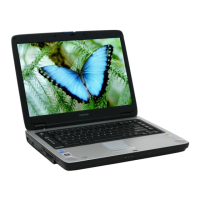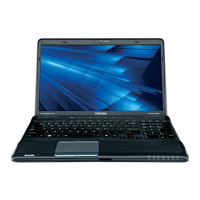
Do you have a question about the Toshiba Satellite A350 Series and is the answer not in the manual?
| Processor | Intel Core 2 Duo |
|---|---|
| Operating System | Windows Vista Home Premium |
| Optical Drive | DVD SuperMulti Drive |
| Chipset | Intel PM45 |
| Webcam | 1.3 MP |
| Battery Life | Up to 3 hours |
| Resolution | 1280 x 800 pixels |
| Storage | 250 GB HDD |
| Graphics | ATI Mobility Radeon HD 3470 |
| Weight | 2.7 kg |
| Display | TruBrite TFT LCD |
| Wireless | 802.11a/g/n Wi-Fi |
| LAN | 10/100 Ethernet LAN |
| Card Reader | 5-in-1 card reader |
| Ports | 3 x USB 2.0, 1 x HDMI, 1 x VGA, 1 x RJ-45 |
| Display Size | 16 inches |
| RAM | Up to 4 GB DDR2 SDRAM (configurable) |
Details manual contents, conventions, abbreviations, icons, keys, and key operations.
Guidelines for setting up the computer in a safe and optimal working environment.
Covers stress, heat, pressure/impact injuries, mobile phone interference, and safety manual.
Lists included hardware and outlines the computer's key features and components.
Details pre-installed software, utilities, and unique features for enhanced usability.
Identifies external parts of the computer from different angles.
Details components like speakers, webcam, touchpad, fingerprint sensor, and function buttons.
Explains optical disc drives, remote controllers, and media card slots.
Guides through connecting the AC adaptor, opening the display, and turning the computer on.
Explains power modes (Shut Down, Hibernation, Sleep) and system recovery options.
Instructions for using the touchpad and enrolling/using the fingerprint sensor.
Covers loading, removing, and handling CD/DVD discs.
Details sound system, webcam, face recognition, modem, LAN, and wireless communication.
Provides guidance on cleaning, moving, and managing computer heat.
Explains typewriter keys, function keys, FN key combinations, and special Windows keys.
Covers hot keys, zooming utilities, FN sticky key, keypad overlay, and ASCII character generation.
Details power conditions, indicators, battery types, care, charging, and monitoring.
Explains password utility, starting by password, and system power-up modes.
Guides through accessing and using the HW Setup utility for system configuration.
Covers user/supervisor passwords, display, boot priority, and device settings.
Details memory media, expansion, battery packs, AC adaptors, and battery chargers.
Covers USB drives, eSATA, monitors, HDMI, i.LINK, and security locks.
Steps for diagnosing issues, preliminary checks, and analyzing problems.
Addresses issues with system start-up, power, battery, drives, and peripherals.
Provides solutions for problems with optical drives, USB devices, modems, LAN, and wireless.
Guidance on seeking assistance from TOSHIBA or local service providers.
Details CPU and system architecture performance variations.
Covers disclaimers for battery life, storage, LCD, GPU, wireless, and other components.
Lists operating and non-operating environmental conditions and power requirements.
Explains how the display controller interprets commands and supports video modes.
Details modem speeds, capabilities, and connection modes.
Outlines form factor, compatibility, OS support, protocol, and data rates.
Covers radio characteristics, range factors, and supported frequency sub-bands.
Lists requirements for length, wire size, current, and voltage rating.
Identifies certification agencies for power cords in different regions.
Provides definitions for technical terms, abbreviations, and concepts used in the manual.










